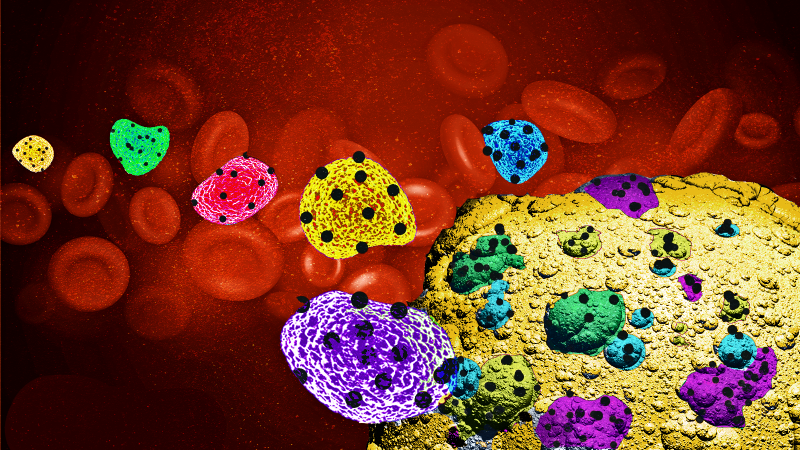
Cells in our body live and work in harmony with each other to keep it alive. Sometimes, due to exposure to harmful chemicals or intense radiation, or even during internal duplication, genes inside few cells can get damaged. At times, the damage makes the cells deviate from their usual behaviour and go rogue. The rogue cells increase in number and form an unholy band that do not respect boundaries and suck even the nutrients meant for healthy cells. These cells are what we call cancer. Gradually and stealthily, they invade new territories and spread to other parts of the body. At this stage, cancer is generally considered to be untreatable.
Cancer mass is a mixture of cells with properties slightly different from each other. Cells differ in size and flexibility or stiffness. In some types of cancer, different types of cells assemble and move together. Researchers from the Indian Institute of Technology Bombay (IIT Bombay) have found that such a rogue hunting party containing a mixture of different cancer cells is more invasive than a band of soldier-like uniform cells. Researchers ran computer models that they had developed and found that typically small and soft cells are most invasive. They also pointed out that smaller cells that resemble cancer stem cells are most often found at the forefront of invasion. Their study was published in The Company of Biologists’ Journal of Cell Science. This research work received funding from the Science and Engineering Research Board (SERB), Department of Science and Technology, Ministry of Science and Technology, Government of India.
All the cells in our body are embedded in a matrix made of proteins and other chemicals. As cancer advances, the cancer cells start invading new tissues. It is not easy for cells to move through dense sticky matrices. Cancer cells secrete several enzymes to soften the matrix and help them wade through it.
The researchers chose two types of breast cancer cells that were primed for an invasion.They analyzed how big each kind of cell is and how strongly each cell binds to its neighbour. Additionally, they measured how fast the cells move around and how stiff they are. Using computer simulations, they observed how these cells moved around and invaded new parts of the body. They controlled the size and stiffness of the cells or their stickiness towards each other. Also, in the simulations they mixed different types of cells in different proportions. They calculated the total distance that each cell travelled. They observed how far each cell moved from its original place, which is termed as the translocation of the cell.
Translocation is a better indicator of invasiveness than the distance each cell travels. Like football players who can pass around the ball a lot and yet fail to break the defence, cells can also move around but still fail to invade new territory. The researchers found that translocation as a whole for a group of cells was maximum in groups that consisted of cells different from each other in size and stiffness. Interestingly, the groups of cells that consisted of cells differing in size alone or stiffness alone were not very efficient invaders. They found that a combination of cells of different sizes and stiffness was the most aggressively invading combination.
The researchers created five different groups of cells. They tested the invasiveness of each group independently to find whether any specific combination of a particular size or stiffness was the most invasive. All cells in each group were uniform but had size or stiffness different from cells in other groups. They found that there was a negligible difference in the invasiveness of each of the individual groups.
Why is a heterogeneous mixture of cells so efficient at invading? The explanation provided is very reminiscent of a pretty successful strategy in football called ‘Total Football’. The Dutch football team is known to have practiced it in the 1970s. As opposed to ‘formations’, where the players play in fixed positions, in Total Football, players move around fluidly and replace another player’s position, effectively maintaining full pressure of attack on the opponent’s defence. What we observe with the cells here is similar to this strategy. “Heterogeneity enables cells to continuously re-position individual cells within a collectively moving group of cells. This enhances the net invasiveness of the cell population,” explains Dr Sen, who led the current research.
The cancer mass contains cancer stem cells that can endlessly increase in numbers, just like normal stem cells. Experimental studies have pointed out that some of these stem cells are relatively softer and smaller in size and are found at the leading front. These simulation studies also found that the same smaller cells were found at the leading front of the invasion. The less invasive cells of the group follow these more aggressive leader cells and strengthen the attack.
True to the adage that diversity in a team imparts the ability to solve a complex problem, a mixed bag of cells with different sizes and stiffness is the most efficient combination for cancer cells to invade. In this heterogeneous group, the cells are interacting with each other during the invasion. One day we may be able to exploit this interaction to kill the cancer cells. We may evolve a strategy to interfere with this crosstalk and hinder their invasion. Perhaps we may then be able to outwit cancer even at this final invasion stage.
This article has been run past the researchers, whose work is covered, to ensure accuracy.






